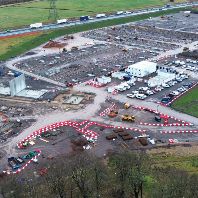The latest iteration of Cushman & Wakefield’s Commercial Real Estate Liquidity Tracker showed the rapid rise in assets withdrawn from the market since the beginning of the COVID-19 lockdown which understandably corresponded with a slowing in transaction activity. However, where deals have taken place, pricing is remaining relatively firm.
Jason Winfield, Head of UK Capital Markets at Cushman & Wakefield, said: “Buyers looking for big discounts in the wake of COVID-19 are likely to be disappointed. As we saw after the vote to leave the EU, sellers seem willing to hold out and wait for a better price later in the year when some stability is expected to return to the market, rather than accept any chip on pricing now. The strong fundamentals that underpin the appeal of commercial real estate assets as a whole has changed very little and once travel restrictions are lifted, we can anticipate an uptick in activity albeit with reduced transaction volumes.”
The first two months of the year saw record levels of new stock offered to the market with €8.2bn (£7.4bn) offered - an 86% increase on the same period a year ago. As the COVID-19 pandemic impacted the market and restricted social interaction and viewings, stock offerings reached record lows – with just €697.4m (£630m) offered in the past two months versus a monthly average of €2.2bn (£2bn).
Over €3.2bn (£2.9bn) of assets had been withdrawn from the market by the end of May, with €1.1bn (£1bn) pulled in April alone. This equates to 20% of stock offered to-date in 2020. By comparison, 2019 saw withdrawals from the market reach 5-10% equating to €5.5bn (£5bn) of stock. This response mirrors the market reaction following the EU referendum in 2016 when 20-25% of stock was withdrawn in the six months following the vote to leave.
“Given the shock that COVID-19 has brought to the market, and the energy required by all firms to assess what it meant for their business, the release of €697.4m (£630m) of new stock underscores the underlying health in the market with many more vendors preparing assets for sale. There is little evidence of forced sellers, and the few deals that have taken place are showing only marginal discounts, which some sellers already have factored into their sales plans,” said Winfield.
Deal volumes have slowed and assets are taking longer to go under offer and complete. Assets have taken on average seven months to complete over the past three months versus six months for 2019, with assets now taking six months to go under offer in the last three months versus under five months in 2019. Against this background, commercial real estate prices are coming under growing pressure as COVID-19 directly impacts economic activity and income levels.
Dr Nigel Almond, Head of Data Analytics, EMEA Research at Cushman & Wakefield, said: “We see variations in pricing across asset classes and geographies. Industrial and logistics remains in vogue and continue to trade at a premium of 1.3%. Offices are trading roughly at par to quoting. Regional offices outside London, the South East and East of England are even trading at a marginal 0.8% premium. Central London offices have seen trades at a marginal discount of 0.8% to quoting, with prime assets trading at quoting supported by stronger demand and lack of stock, and a broad range of underbidders. The structural change impacting retail long predates COVID-19 and assets have been trading at double-digit discounts to quoting of 12% with supermarkets the only shining light amidst the wider gloom with trades at a more marginal 3%”.
Martin Lay, Co-Head of London Capital Markets at Cushman & Wakefield, said: “We are starting to see green shoots appear in investment activity after three months of lockdown with investors selectively looking to re-engage on investment opportunities. Some deal transactions in excess of €110.7m (£100m) have gone under offer in the last two weeks and at pricing levels in line with those that we would have witnessed at the beginning of the year including 1 New Oxford Street and Fleet Place House. This is likely to provide encouragement to other owners to dust off plans for assets which they had considered bringing to the market but subsequently put things on hold, starting the engine for greater liquidity in the second half of the year.”















